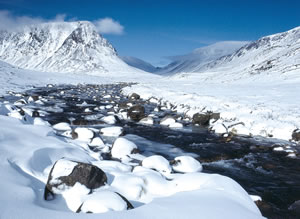 Hostile
Habitats : Scotland's Mountain Environment, A Hillwalker's Guide to the Landscape
and Wildlife. Edited by Nick Kempe and Mark Wrightam. Scottish Mountaineering
Trust, £15. ISBN 0-907521-93-2.
Hostile
Habitats : Scotland's Mountain Environment, A Hillwalker's Guide to the Landscape
and Wildlife. Edited by Nick Kempe and Mark Wrightam. Scottish Mountaineering
Trust, £15. ISBN 0-907521-93-2. Hostile
Habitats : Scotland's Mountain Environment, A Hillwalker's Guide to the Landscape
and Wildlife. Edited by Nick Kempe and Mark Wrightam. Scottish Mountaineering
Trust, £15. ISBN 0-907521-93-2.
Hostile
Habitats : Scotland's Mountain Environment, A Hillwalker's Guide to the Landscape
and Wildlife. Edited by Nick Kempe and Mark Wrightam. Scottish Mountaineering
Trust, £15. ISBN 0-907521-93-2.
This book sets out to fill a gap. As the editors point out in their introduction, "Scottish mountaineering is served by an extensive literature....but with some exceptions, this barely touches on the mountain environment." Much of the existing research is inaccessible to non-specialists and identification guides to, for example, plants and birds generally cover rather wider geographical areas, typically the British Isles or Northern Europe. The editors aim, therefore, is to draw together the available information into "a single accessible source dedicated to the Scottish hills."
The scope of the mountain environment is defined as being "everything above the level of enclosed and more intensively managed farmland" and the international importance of that environment is asserted. The book's Overview argues that the influence of a mild, wet oceanic climate combined with some characteristics of colder, drier ranges on the mainland of Europe has resulted in the Scottish mountains becoming "a melting pot for wildlife of temperate and arctic zones".
Chapters 1 to 8 devote themselves to the various aspects which go to make up that environment and are contributed by authors who are both specialists in their fields and enthusiastic recreational users of the mountains. Beginning with climate and geological foundations, we are successively taken through landscape formation, vegetation, invertebrates, birds, mammals, reptiles, amphibians and fish down to the surviving traces of various forms of human activity. Former NEMT Chair Roger Owen has co-authored the chapter on Mammals, Reptile, Amphibians and Fish.
Hill-goers cannot fail to find something of interest in the content of these chapters. The book is well illustrated throughout and, where appropriate, chapters conclude with an illustrated identification guide to individual rock types, plants, birds etc. It is a little too substantial to be comfortably shoved in a rucksack so advance study or a photographic memory is called for. Now if someone could find a way of storing the identification sections on a mobile phone or hand-held GPS.... The index provides access under broad headings such as Birds (individual species); Birds, general; Climate etc. My only criticism here is that it would have been good to index also by specific mountain so that, if you were heading off to Ben X, you could easily check what rock forms, plants or bird species you might expect to see.
The final chapter, contributed by Nick Kempe, considers "The Future of Our Mountains". He asserts the importance of the Scottish mountains as an ecological and, increasingly, a social resource. (How many of us know that Scotland supports probably the finest range of liverworts in the world?) He then reviews issues relating to the use and management, conservation, protection and recreational use of the mountain environment. What he has deliberately not done is to do more than touch on some key current debates such as windfarms or woodland regeneration. His belief is that "there is a need for our society to consider the wider questions of what the natural environment, including mountains, is for and what role humans should play in them." He ends the chapter and the book by quoting W.H. Murray:
"Land and wildlife have their own being in thier own right. Our recreation is an incidental gain, not an end in itself to be profitably pursued by exploiting land where that means degrading it. The human privilege is to take decisions for more than our own good; our reward that it turns out to be best for us too."
Get hold of this book if you possibly can.
Will Campbell
24 October 2006
Image: Mark Wrightham The Lairig Ghru is a spectacular glacial breach cutting through the plateaux of the central Cairngorms. The former 'east ridge' of Devil's Point, left, has been shaved off by glacial erosion, forming a truncated spur.
Please let the webmaster know if there are problems with viewing these pages or with the links they contain.